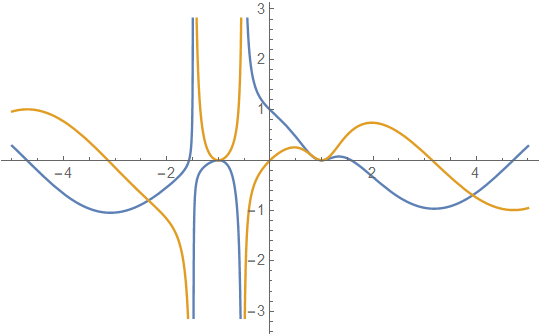Mathematica finds
Integrate[Exp[I*s]/(1 + s/(s^2 - 1)^2), {s, -Infinity, Infinity}, PrincipalValue -> True] // ToRadicals
(*A huge closed-form expression which is omitted here.*)
N[%]
(*-1.414 + 0.192275 I*)
The use of the principal value is grounded by the plots
Plot[{Cos[s]/(1 + s/(s^2 - 1)^2),Sin[s]/(1 + s/(s^2 - 1)^2)},{s,-5,5},WorkingPrecision->30,PlotPoints -> 50]
It's clear that the integrand has its real singularities at the real roots of the denominator, so
sol = Reduce[1 + s/(s^2 - 1)^2 == 0, s, Reals] // ToRadicals;
sol[[1]][[2]]
(*-(1/(2 Sqrt[3/(4 + (155/2 - (3 Sqrt[849])/2)^(1/3) + (1/2 (155 + 3 Sqrt[849]))^(1/3))]))
- 1/2 Sqrt[8/3 - 1/3 (155/2 - (3 Sqrt[849])/2)^(1/3) - 1/3 (1/2 (155 + 3 Sqrt[849]))^(1/3) +
2 Sqrt[3/( 4 + (155/2 - (3 Sqrt[849])/2)^(1/3) + (1/2 (155 + 3 Sqrt[849]))^( 1/3))]]*)
N[%]
(*-1.49022*)
sol[[2]][[2]]
(*-(1/(2 Sqrt[3/(4 + (155/2 - (3 Sqrt[849])/2)^(1/3) + (1/2 (155 + 3 Sqrt[849]))^(1/3))])) +
1/2 Sqrt[8/3 - 1/3 (155/2 - (3 Sqrt[849])/2)^(1/3) -
1/3 (1/2 (155 + 3 Sqrt[849]))^(1/3) + 2 Sqrt[3/( 4 + (155/2 - (3 Sqrt[849])/2)^(1/3)+(1/2 (155 + 3 Sqrt[849]))^( 1/3))]]*)
However, I have doubts concerning the obtained principal value because the integrand asymptotically equals $\exp(is)$ as $s\to \infty$ and $s\to -\infty$ and $$PV\int_{-\infty}^\infty \exp(is)\,ds $$ does not exist.
In view of it I try to verify it numerically through
NIntegrate[Exp[I*s]/(1+s/(s^2-1)^2),{s,-Infinity,
-(1/(2 Sqrt[3/(4+(155/2-(3 Sqrt[849])/2)^(1/3)+(1/2 (155+3 Sqrt[849]))^(1/3))]))-
1/2 Sqrt[8/3-1/3 (155/2-(3 Sqrt[849])/2)^(1/3)-1/3 (1/2 (155+3 Sqrt[849]))^(1/3)+
2 Sqrt[3/(4+(155/2-(3 Sqrt[849])/2)^(1/3)+(1/2 (155+3 Sqrt[849]))^(1/3))]],
-(1/(2 Sqrt[3/(4+(155/2-(3 Sqrt[849])/2)^(1/3)+(1/2 (155+3 Sqrt[849]))^(1/3))]))+
1/2 Sqrt[8/3-1/3 (155/2-(3 Sqrt[849])/2)^(1/3)-1/3 (1/2 (155+3 Sqrt[849]))^(1/3)+
2 Sqrt[3/(4+(155/2-(3 Sqrt[849])/2)^(1/3)+(1/2 (155+3 Sqrt[849]))^(1/3))]],Infinity},
Method->"PrincipalValue",AccuracyGoal->3,PrecisionGoal->3,WorkingPrecision->50]
which results in the error message
NIntegrate::ncvb: NIntegrate failed to converge to prescribed accuracy after 9 recursive bisections in s near {s} = {3.7749613270651398879039428756113970426387939277790*10^28}. NIntegrate obtained 8.8211977939280824575415993952100374290963331174834*10^47 I and 9.1940327832901306869987159913883594088789773626283`50.*^47 for the integral and error estimates.
and
(*-2.6098684408162971553635553440779848277629513026488*10^49 +
8.8211977939280824575415993952100374290963331174789*10^47 I*)
Constructive suggestions are welcome.
Addition. @b.gates.you.know.what in her/his answer suggests to use FourierTransform to this end. This is not it. Here is an example:
Limit[Integrate[Exp[I*t], {t, -a, a}], a -> Infinity]
(*Indeterminate*)
but
FourierTransform[1, y, t] /. t -> 1
(*0*)
-


Maple 2020give me a symbolic solution or using numerics:-0.998307 - 0.313707 I.Using FourierTransform inMathematica 12.1-FourierTransform[1/(1 + s/(s^2 - 1)^2), s, t, FourierParameters -> {1, -1}] /. t -> -1 // ToRadicalsgive me also the same output:-0.998307 - 0.313707 I.Probably looks like a bug in MMA? $\endgroup$FourierTransformare reliable in this field. BTW, whyt->-1? $\endgroup$FourierTransformshould be taken into account. $\endgroup$t=1,but in this case imaginary part is positive.That is strange in Maple is negative.I am confused. $\endgroup$